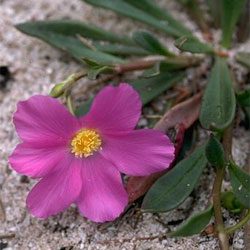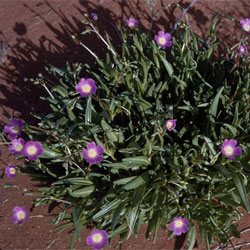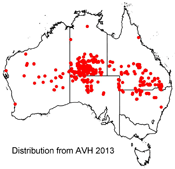Calandrinia balonensis
 |
 |
Broad-leaved Parakeelya, Balonne Parakeelya
Calandrinia balonensis had long been a mainstay in Aboriginal culture prior to its discovery in 1846 by early European explorers in the region of the Balonne River. Aboriginals made use of the roots and leaves for food, and if enough could be collected, ground the seeds down to a paste to use in cooking. The common name Parakeelya for C. balonensis (and other members of the genus) is derived from one of the Aboriginal names for the plants.
 C. balonensis is from the Portulacaceae family, also known as the purslane family, which is comprised of around 20 genera with about 500 species. It is prolific in the arid regions west of the Great Divide spreading out across central Australia into Western Australia and is commonly found growing in, though certainly not restricted to, red sandy soils and spinifex zones.
C. balonensis is from the Portulacaceae family, also known as the purslane family, which is comprised of around 20 genera with about 500 species. It is prolific in the arid regions west of the Great Divide spreading out across central Australia into Western Australia and is commonly found growing in, though certainly not restricted to, red sandy soils and spinifex zones.
It is a prostrate to erect annual/biennial herb with succulent leaves that at a distance may not appear succulent. A plant can produce many flowering stems up to 60cm high topped by flowers with broad bi-coloured petals, mainly pink-purple becoming bright yellow at the base, that frame fluffy yellow stamens. It can flower constantly during the warm months.
This plant lends itself readily to cultivation and makes a great potted ornament. It will easily thrive in the ground or pot with well-drained, airy soil and loves a dry, sunny location. It has a preference for hot weather and will not grow well in the cold months though this can be overcome by placing the plant in shelter such as a greenhouse or even possibly under a covered courtyard, depending on how extreme the cold is. It may struggle in the ground in humid environments, but moving it to a hanging pot where it gets lots of sunlight should solve this problem. C. balonensis grows extremely well from stem cuttings off both juvenile and mature plants and in a garden or nursery setting this is the preferred method for propagation. It should strike with no trouble but a low strength rooting hormone can be used if you are having trouble. In its natural environment it is a seed propagator, producing tiny black seeds, and it will self-sow in the garden or pot.
C. balonensis is as easy to maintain as it is to grow. Water as needed, probably once per day in dry hot weather, in the winter only once or twice a week. To promote more growth you may like to prune the flowering stems before they develop. Though a hardy grower, it is a delicate plant and will break easily if handled roughly.
Text by Wade Gilbert (2013 Student Botanical Intern); last edited 18 February 2014 by A.M.Monro.
Name meaning: Calandrinia balonensisCalandrinia – after the 19th century Swiss professor and botanical author Jean Louis Calandrini balonensis – after the area the first specimen was found, the Balonne River in Queensland |
References:
AussieColours (n.d.) Calandrinia ‘Mystique’ (Calandrinia balonensis) Fact Sheet. Available at http://www.aussiecolours.com.au/factsheet/Calandrinia%20mystique%20Fact%20Sheet_3_11_10.pdf [accessed 29 May 2013].
Kapitany, A. (2007) Australian Succulent Plants, Kapitany Concepts, Boronia, Vic.
Kapitany, A. (2011) The Australian Calandrinia, Kapitany Concepts, Boronia, Vic.
Low, T. (1989) Wild Food Plants of Australia, Harper Collins Publishers (Australia) Pty Ltd.
Mitchell, T.L. (1848) Journal of an Expedition into the Interior of Tropical Australia, Longman, Brown, Green and Longmans, Paternoster-row, London.
![An Australian Government Initiative [logo]](/images/austgovt_brown_90px.gif)

